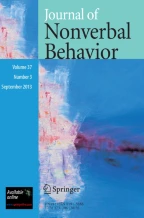Abstract
Previous research suggests differences in lip movement between deliberate and spontaneous facial expressions. We investigated within participant differences between deliberately posed and spontaneously occurring smiles during a directed facial action task. Using automated facial image analysis, we quantified lip corner movement during periods of visible Zygomaticus major activity. Onset and offset speed, amplitude of movement, and offset duration were greater in deliberate smiles. In contrast to previous results, however, lip corner movement asymmetry was not greater in deliberate smiles. Observed characteristics of deliberate and spontaneous smiling may be related to differences in the typical context and purpose of the facial signal.
Similar content being viewed by others
References
Ambadar, Z., Cohn, J., & Reed, L. I. (2005). All smiles are not created equal: Timing characteristics and interpretations of spontaneous smiles. Manuscript in preparation
Brown W. M., Moore C., (2002). Smile asymmetries and reputation as reliable indicators of likelihood to cooperate: An evolutionary analysis. In Shohov S., (Ed.), Advances in psychology research (Vol. 11) Nova Science Publishers Huntington, NY, 59–78
Bugental D., (1986). Unmasking the “polite smile”: Situational and personal determinants of managed affect in adult–child interaction Personality and Social Psychology Bulletin 12:7–16
Cohn J. F., Reed L. I., Ambadar Z., Xiao J., & Moriyama T. (2004). Automatic analysis and recognition of brow actions and head motion in spontaneous facial behavior. Proceedings of the IEEE Conference on Systems, Man, and Cybernetics (pp. 210–216). The Hague, the Netherlands
Cohn J., Schmidt K. L., (2004). The timing of facial motion in posed and spontaneous smiles International Journal of Wavelets, Multiresolution, and Information Processing 2:1–12
Cohn J., Xiao J., Moriyama T., Ambadar Z., Kanade T., (2003). Automatic recognition of eye blinking in spontaneously occurring behavior. Behavioral Research Methods and Instrumental Computing 35:420–428
Ekman P., Davidson R. J., Friesen W. V., (1990). The Duchenne smile: Emotional expression and brain physiology II Journal of Personality and Social Psychology 58:342–353
Ekman P., Friesen W. V., (1978). Facial action coding system. Consulting Psychologists Press Palo Alto
Ekman P., Friesen W. V., Hager J. C., (2002). The facial action coding system (2 ed.).Research Nexus eBook Salt Lake City
Frank M. G., Ekman P., Friesen W. V., (1993). Behavioral markers and recognizability of the smile of enjoyment Journal of Personality and Social Psychology 64:83–93
Hager J. C., Ekman P., (1997). The asymmetry of facial actions is inconsistent with models of hemispheric specialization. In Ekman P., Rosenberg E., (Eds.), What the face reveals Oxford University Press New York, 40–62
Hess U., Kappas A., McHugo G. J., Kleck R. E., Lanzetta J. T., (1989). An analysis of the encoding and decoding of spontaneous and posed smiles: The use of facial electromyography Journal of Nonverbal Behavior 13:121–137
Hess U., Kleck R., (1997). Differentiating emotion elicited and deliberate emotional facial expressions. In Ekman P., Rosenberg E., (Eds.), What the face reveals Oxford University Press New York, 271–285
Kanade, T., Cohn, J. F., & Tian, Y., (2000). Comprehensive database for facial expression analysis. Proceedings of the Fourth IEEE International Conference on Automatic Face and Gesture Recognition (FG’00) (pp. 46–53). Grenoble, France
Keltner D., (1995). Signs of appeasement: Evidence for the distinct displays of embarrassment, amusement, and shame Journal of Personality and Social Psychology 68:441–454
Krumhuber E., Kappas A., (2005). Moving smiles: The role of the dynamic components for the perception of the genuineness smiles Journal of Nonverbal Behavior 29:3–24
Lien J.-J., Kanade T., Cohn J. F., Li C.-C., (2000). Detection, tracking, and classification of subtle changes in facial expression Journal of Robotics and Autonomous Systems 31:131–146
Preuschoft S., (1992). Laughter and smile in barbary macaques (Macaca sylvanus) Ethology 91:220–236
Schmidt K., Cohn J., (2001). Human facial expressions as adaptations: Evolutionary perspectives in facial expression research Yearbook of Physical Anthropology 116:8–24
Schmidt K., Cohn J., Tian Y., (2003). Signal characteristics of spontaneous facial expressions: Automatic movement in solitary and social smiles Biological Psychology 65:49–66
Skinner M., Mullen B., (1991). Facial asymmetry in emotional expression: A meta-analysis of research British Journal of Social Psychology 30:113–124
Smith M. C., Smith M. K., Ellgring H., (1996). Spontaneous and posed facial expression in Parkinson’s disease Journal of International Neuropsychological Society 2:383–391
Soussignan R., (2002). Duchenne smile, emotional experience, and autonomic reactivity: A test of the facial feedback hypothesis Emotion 2:52–74
Tian Y.-l., Kanade T., Cohn J. F., (2001). Recognizing action units for facial expression analysis IEEE Transactions on Pattern Analysis and Machine Intelligence 23:97–115
Xiao J., Moriyama T., Kanade T., Cohn J., (2003). Robust full-motion recovery of head by dynamic templates and re-registration techniques International Journal of Imaging Systems and Technology 13:85–94
Author information
Authors and Affiliations
Corresponding author
Additional information
Karen L. Schmidt, Zara Ambadar, Jeffrey F. Cohn, and L. Ian Reed are affiliated with the University of Pittsburgh, Pittsburgh, PA 15260, USA.
Jeffrey F. Cohn is also affiliated with the Carnegie Mellon University, Pittsburgh, PA 15260, USA.
This research was supported by NIMH Grants MH15279 and 167376 to Karen L. Schmidt, and NIMH Grant MH 51435 to Jeffrey F. Cohn. We gratefully acknowledge the assistance of Adena Zlochower in digitizing videotape used in this analysis and Rachel Levenstein in the analysis of data described in this paper.
Address correspondence to Karen L. Schmidt, University of Pittsburgh, 121 University Pl, Pittsburgh, PA 15260, USA; E-mail: kschmidt@pitt.edu
Rights and permissions
About this article
Cite this article
Schmidt, K.L., Ambadar, Z., Cohn, J.F. et al. Movement Differences between Deliberate and Spontaneous Facial Expressions: Zygomaticus Major Action in Smiling. J Nonverbal Behav 30, 37–52 (2006). https://doi.org/10.1007/s10919-005-0003-x
Published:
Issue Date:
DOI: https://doi.org/10.1007/s10919-005-0003-x
